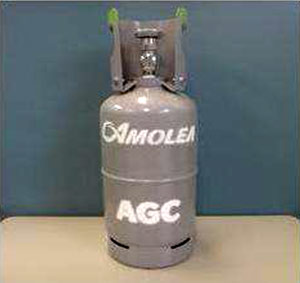What future for R410A?
26th August 2015 Interesting new low GWP alternative refrigerants, combined with an expected relaxation of charge limits on flammable refrigerants, suggest that the days of R410A being the commercial air conditioning refrigerant of choice could soon be numbered.
Interesting new low GWP alternative refrigerants, combined with an expected relaxation of charge limits on flammable refrigerants, suggest that the days of R410A being the commercial air conditioning refrigerant of choice could soon be numbered.
R410A has been the refrigerant of choice in Europe and elsewhere since first introduced in the mid-90s as a replacement for ozone-depleting R22. It is also now being introduced in some of the major world markets and the developing countries as R22 becomes more widely phased out under Montreal Protocol agreements. But what does the future hold for this gas?
Except for being effectively banned in new small single-split air conditioning systems from 2025 and in portables from 2020, R410A has been untouched by the latest European F-gas regulations. So, while the commercial refrigeration refrigerants R404A and R507, with their high GWPs of around 3300, will be no more in both Europe and the US in just a few years, R410A soldiers on. Or does it?
With such high GWPs, R404A and R507 were obvious targets for bans – but only because there are lower GWP alternatives already available. Such is also the case with R134a. In Europe and elsewhere, hydrocarbons have been used as the R134a alternative in domestic fridges for many years; likewise in small commercial plug-in fridges. And, despite some opposition in Germany, the HFO R1234yf is available to replace R134a in vehicle air conditioning systems. With so many options now available R134a has been targeted for phase-out in these applications in both Europe and the USA.
R134a has a GWP of 1430. R410A’s GWP is 2088, almost 50% more than R134a. So why no ban for R410A? The obvious most practical reason is that there is currently no available viable alternative for use in commercial air conditioning systems.
R32 is being promoted by Daikin and others for use in small splits and propane is also being considered in similar applications in some Far East markets. However, their flammability precludes their use under current national and international safety standards in all but the smaller systems.
Until now, as well, there has been no international standards recognition of the “mildly flammable” A2L category, apportioned by ASHRAE to refrigerants like R32. With new agreed revisions to standards, however, we will shortly see charge sizes being relaxed for the A2L gases, allowing charges up to as much as 60kg.
And there are more A2L blends under development which could challenge R32 as potential R410A replacements. It should be noted that all are expected to be classified as “mildly flammable” A2L.
Development of R410A alternatives
Just last week, Ingersoll Rand announced it would debut a Trane air-cooled chiller employing a new Chemours R410A replacement development refrigerant at the ICR2015 conference in Japan. Known as DR-55, this HFO/HFC blend is currently being evaluated for use in unitary and residential equipment.
Chemours, who will market the new gas as Opteon XL55, go further describing it as being suitable for residential, light commercial and commercial window units, portables, mini-splits, ducted splits, PTACs, commercial packaged, multi-splits and DX chillers.
With a GWP of only 676 It is said to be the most optimised low GWP replacement for R410A, achieving a 5% energy efficiency improvement. It is also said to offer excellent performance in high ambient conditions and has a low temperature glide of just -1K.
Chemours says it expects, pending regulatory approval, that hvac systems using DR-55 will be available within the next 12-18 months.
Chemours also has Opteon XL41, which already carries the ASHRAE classification R-454B. XL41 was formerly the development refrigerant DR-5, a blend of HFO 1234yf and R32. At 460, XL41 offers a lower GWP than DR-55 but Chemours admits that DR-55 offers a better combination of performance and flammability.
 Honeywell has been working on at least two R410A alternatives – L20 and L41. In fact, at least two version of L41 have been mentioned, both comprising R32 and HFO1234ze with one also including some HFO1234yf.
Honeywell has been working on at least two R410A alternatives – L20 and L41. In fact, at least two version of L41 have been mentioned, both comprising R32 and HFO1234ze with one also including some HFO1234yf.
Not to be outdone, Arkema and Mexichem are also developing alternatives that are said to be close matches to R410A. Arkema is known to have been working on ARM-71a, another A2L with a GWP of under 500. ARM-71a is said to possess a lower discharge temperature than R32 and a low glide. Mexichem’s offering is HPR2A with a GWP though to be around 600.
Last year a new combatant entered the fray when Japanese company Asahi Glass announced that it, too, would be producing an R410A replacement. Perhaps uniquely, this new refrigerant blend which it was calling Amolea, was based on yet another new HFO molecule, 1123. Little has been heard since but the company was predicting its introduction in 2016.
R410A’s position is unlikely to change in the short-term but if the new lower GWP alternatives are proven to be viable and compatible in commercial systems with the new flammable refrigerant charge limits, a future ban in certain new applications seems likely. Fortunately, any possible future restrictions are unlikely to affect any R410A systems installed in the next five to ten years and will still be compliant and serviceable for the expected 15-plus years of the working life of most commercial systems.
Related stories:
R32 performs well in drop-in test – August 18, 2015
USA: The lower GWP refrigerant R32 is said to have shown similar performance to R410A in drop-in tests on a single-package vertical heat pump. Read more…
R410A option may contain HFCs and HC – April 1, 2014
JAPAN: The Cooling Post has uncovered the potential blend constituents of the new low GWP replacement for R410A recently announced by Japanese refrigerant manufacturer Asahi Glass. Read more…







